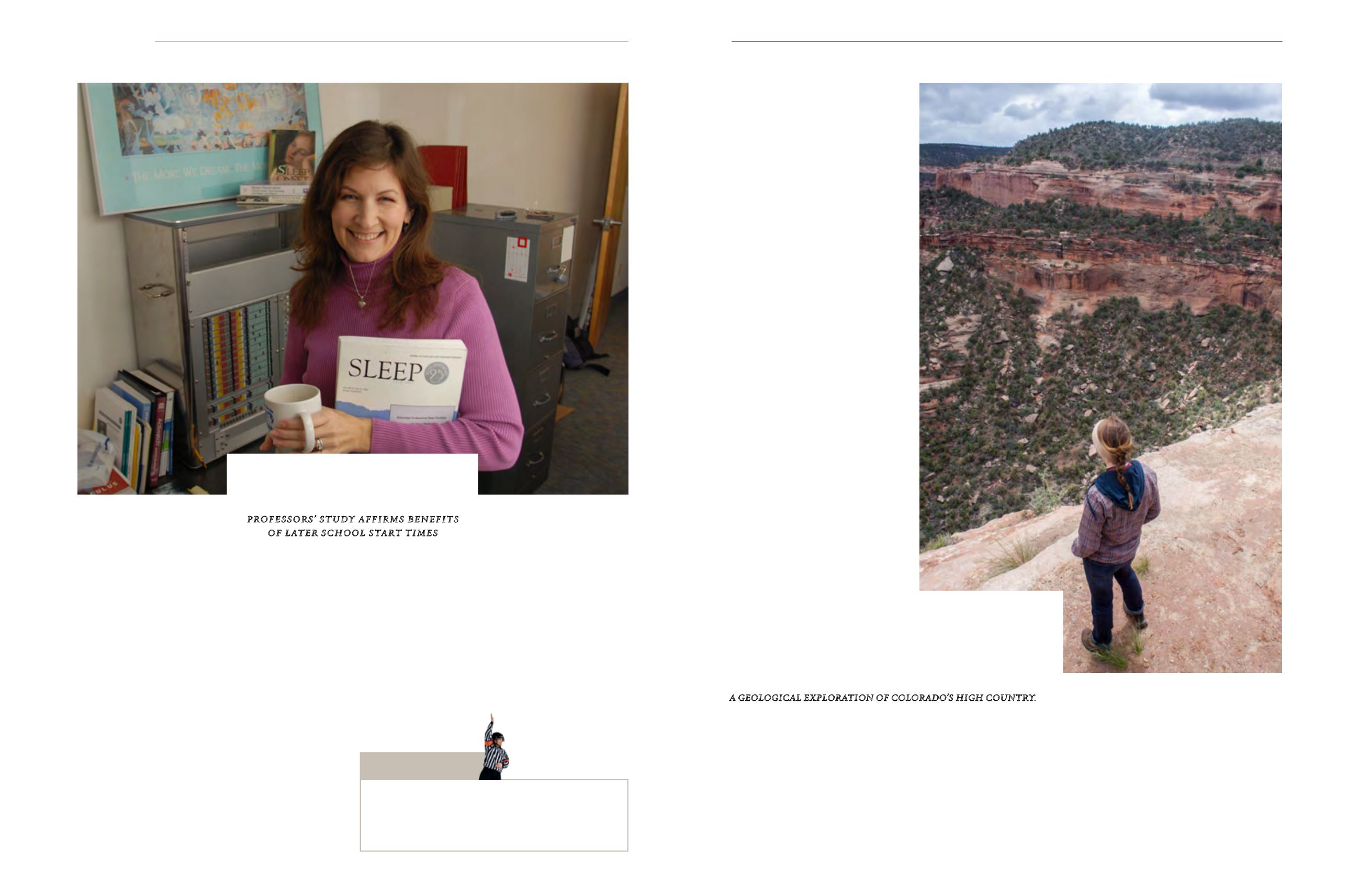

10
11
on campus
st. lawrence university magazine | winter 2015
changes” at Glens Falls High
School but enough to support
what she called “the profound
benefits” of later start times:
improved sleep patterns, bet-
ter behavior, lower absence
and tardiness rates, more
alertness and higher retention
rates. She found a decrease in
incidents of assault, intimida-
tion, and negative behaviors
to push its opening bell 85
minutes later, Thacher and As-
sociate Professor of Psychology
Serge Onyper began collecting
data from nearly 600 students.
Thacher said she hoped to dis-
cover if it really is “worthwhile
for school districts to move to
later start times.”
Thacher took into account
potential costs associated with
shifting, such as alterations to
bus runs, effects on after-
school activities, and safety
for children coming home to
empty houses. She said, “We
have to consider that when
the school system changes, the
whole community changes.”
Thacher noted “small
s both
a mother and a psychology
professor at St. Lawrence,
Pamela Thacher (above) un-
derstands the importance of
sleep for her children at home
and her students in college.
Spurred by a national
debate over when the school
day should begin, Thacher
conducted research at Glens
Falls High School beginning
in 2011. In a fall campus
address, she discussed her sup-
port, based on the results, for
later start times.
After the school opted
School Daze
A
Professors ’ study affirms benefits
of later school start times
By Maureen Pellerin ’15
Some stories begin with the accumula-
tion of wind-blown particles and some
with the deposition of tidally-controlled
sediment.
Not only do we learn about the geology
of the western Colorado region; we also
discover the significance of water to the
whole western United States. Unlike in
the eastern U.S., water in the West is
ay 10, 2014: Seven
fellow geology stu-
dents and I arrive at
the End of the Road
Ranch in New Castle,
Colo., ready to commence our week-long
tour of Colorado’s geology.
Jeff Chiarenzelli ’81, Chapin Professor
of Geology and Mineralogy at
St. Lawrence, is our leader, and our
host is ranch-owner John Kelly ’69, an
exceptionally gracious Laurentian. There,
we meet another genial alum, Doug
Reed ’70, as eager as we are to learn more
about western Colorado’s geology.
Each day is packed full of traveling,
hiking and learning. We low-landers
acclimate our oxygen-deprived lungs to
the thin Colorado air on the first day,
hiking up through the deep canyons of
East Elk Creek for nearly eight hours in
heavy rain and snow. On the ascent to
the Legal Tender Mine, we travel through
geologic time from Precambrian granites
and gneisses, more than 540 million
years old, to Cretaceous sandstone and
limestone layers, 144 million to 65 mil-
lion years old.
On another excursion, we explore the
magnificent Colorado National Monu-
ment. We observe grand lithified aeolian
dunes, overturned sandstone beds,
temporally massive unconformities, and
peculiarly balanced rock structures. Sedi-
mentary rocks are the theme of the day.
Chiarenzelli explains the genesis of each
formation and its morphology over time.
M
Dunes, Beds and
Unconformities
scarce. Repercussions include a lack of
water for consumption and production,
and for fire suppression. Kelly tells us the
story of the South Canyon Fire of 1994,
which took 14 young firefighters’ lives;
later, we visit their memorial. It is a mov-
ing experience and one that opens our
eyes to issues that face the driest parts of
North America.
n
a geological exploration of Colorado’s high country.
Hannah Drummond ’15, overlooking the
Colorado National Monument.
By Hillary Hagen-Peter ’14
Penalty Box
Our bad
: In the caption accompanying the St. Lawrence
restaurant sign (Fall 2014, Page 4) we got story
provider Macreena Doyle’s title wrong. She is director of
employee recruitment, training & Affirmative Action.
such as insubordination and
substance abuse.
Although grades were not
significantly improved by
the change, Thacher was still
pleased with the results, say-
ing, “I’m happier if I get less
tardiness and better behavior.
I want my own kids to go to a
school where their classmates
aren’t creating problems.”
n



















